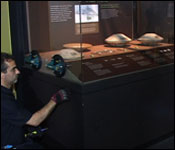
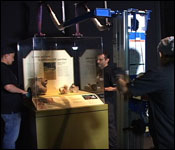
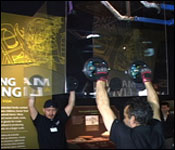
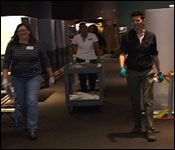
A climate controlled eighteen wheeler is tonight on a 3,000 mile journey from Boston to San Diego. But this is not just another cargo truck – in that
truck there are over 250 of Belize's most prized Mayan artefacts, meticulously packed and stored. While these artefacts carry sacred stories of Maya
antiquity, the science of packing them carries a story of its own. News Director Jules Vasquez and cameraman Codie Noralez traveled to Boston this
weekend to capture …..last night you saw a snippet, tonight we bring you the full story….
Jules Vasquez Reporting…
The mouth of the historic Charles River is dammed at the Boston Museum of Science inside, oblivious to the river's pull, technicians are working with
precision to disassemble the display cases known as vitrines which contain some of Belize; most previous artefacts.
They will use this device known as a genie lift where suction cups grip and lift the enormously heavy plexi-glass cover.
 Debbie Linn – Travelling Exhibits Conservator
Debbie Linn – Travelling Exhibits Conservator
"And the machines gets cranked so this whole vitrines gets lifted up while being guided these two gentlemen on the side and i't quite an amazing
process. These vitrines are incredibly heavy but it needs to be done so carefully because the artefacts in the case can't be jiggled
and can't be vibrating during this process. Nothing can be bumped into them, it needs to be very smooth very careful lifting up of this very heavy
piece of plexi glass."
And after the cover is lifted and removed with tender care, The NICH crew moves in to move each artefact with even more tender care.
Two escorts walk in front to make sure nothing is in the way. Yusleidy Chan is learning the responsibilities of what is known as the courier from Sherilyne
Jones. The courier is the boss, she has the final say over all dealings with the objects:
 Sherilyne Jones - Director, Museum of Belize & Houses of Culture
Sherilyne Jones - Director, Museum of Belize & Houses of Culture
"Well, we are here that that punctilious level of care is taken. These objects represent our history, they represent our culture, and so it is our
responsibility as custodians to ensure their viability, to ensure that at every point throughout this loan that they are taken care of with the utmost
care."
Jules Vasquez
"Do you feel a pressure when you're saying, I am in charge of I am managing a large percentage of Belize's history of antiquity?"
 Yusleidi Chan- Collections Manager – NICH
Yusleidi Chan- Collections Manager – NICH
"Of course because if anything goes wrong who they'll look at? Me! And I have to explain what went wrong so it's a big pressure on me."
And from pressure, precision. Each object, after it is removed from the display it has to be carefully examined and reviewed against a copious record of
notes:
Sherilyne Jones - Director, Museum of Belize & Houses of Culture
"What we're doing is we're processing the artefacts as we remove them from the display cases. Its called conditioning, it's just taking a visual of the
object 360 degrees, making comparisons with the notes that we did when we took them out of the crates and put them in. There's always some level of
anxiety – you never know how the elements the time it's been on display how that would affect the object."
And to minimise the anxiety and eliminate uncertainty, there are rules, and manuals and notes:
 Peter Garland - Manager of Temporary Exhibits
Peter Garland - Manager of Temporary Exhibits
"There's a same principle that you follow with everything. Anytime you have artefacts, there's a whole set of rules that come into play, and everyone
learns those rules and no objects gets priority over another."
Sherilyne Jones - Director, Museum of Belize & Houses of Culture
"So there are instructions on how to lift an object, where to touch the object, how to wrap the object so that it's all secure and safe at all times.
There's instructions on how to hold it, there's instructions on how to place it inside the crates, or in the bins, and then there are sponges or
protective padding that you place in, and all those have a precise way of how it goes in so that the object itself doesn't move when it's in transit."
Peter Garland - Manager of Temporary Exhibits
"And even though they are changing crews as they go to different sites, by having that fairly rigid platform of order of things to do it really makes
things go much smoother."
Sherilyne Jones - Director, Museum of Belize & Houses of Culture
"Somebody from Belize, or somebody from NICH is always present when the objects are handled or when the objects are being taken out of the crates, in
the crates, I guess it's just an oversight to ensure that our pieces are being protected."
But there are some pieces that no matter how well protected they are, still suffer from road wear – and they will likely do so over the next three days
when the objects travel three thousand miles from San Diego to Boston:
Sherilyne Jones - Director, Museum of Belize & Houses of Culture
"When there's actual travel involved that's a little more tense – because even though the trucks are aerated there is vibration that takes place in the
packing and so that's a little more stressful in a sense, when we take them out of the crates and take them out of their boxes. My stress level is a
little higher there because I anticipate that something would have shaken off or there might be some kind of stress on the objects."
And there are some troublesome objects that give these folks sleepless nights:
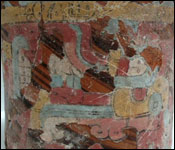 Sherilyne Jones - Director, Museum of Belize & Houses of Culture
Sherilyne Jones - Director, Museum of Belize & Houses of Culture
"In this exhibition there are several objects that give me anxiety. One of them is the stucco vase from Cahal Pech. At every venue that has been
problematic. The nature of the object, it, just before it came on loan, it had just been excavated. Because it is so freshly out of the ground, the
dust and soil is still embedded, and so with the vibration of movement, those tend to fall off. And so there's this (sigh) anxiety level that each time
you open it you're like (sigh) "Lord, let me see what comes off."
For Yusliedi Chan, it's the small figurines known as the bacabs:
 Yusleidi Chan- Collections Manager – NICH
Yusleidi Chan- Collections Manager – NICH
"They have stucco which are the white paint and if you move them or handle them with such care or mis-coordination the stucco falls off so you have to
be very tentative of them. So every time you hold them it sheds a bit – you have to be very patient with it, you have to be very careful with it, any
time you when hold it, when you look at it a little too hard, it sheds. So you have to be very tentative of those little guys, so it's very stressful
when you dealing with them."
And that's where Rebecca Newberry comes in – she's the conservator who travels with the show:
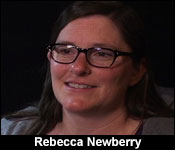 Rebecca Newberry - Conservator
Rebecca Newberry - Conservator
"And some objects in the show have been a little more troublesome than others they're more fragile than we initially thought they were, so we've had to
make changes to the packing and how we handle them to protect them. We're taking these things that are very fresh and still have a lot of the original
pigment and we wanna save that a much of it is saved as possible."
Yusleidi Chan
"And if something do goes wrong, they can be treated whereas back home in Belize it cannot so that's the hard part with that. So that's the beauty of
being here because if something
can be fixed it will be fixed here."
In fact, as strange as it may sound, these artefacts are safer here on the road than they are in storage back in Belize – that's because the place they are
stored in Belize is called, "the Dungeon":
Sherilyne Jones - Director, Museum of Belize & Houses of Culture
"The risks that they are exposed to here in any of these museums in the United States, far, is so minimal compared to what we actually have what right
now. The present condition our storage facility in Belize is, is an abomination to be honest they are safer here in a controlled environment."
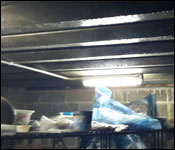 Rebecca Newberry - Conservator
Rebecca Newberry - Conservator
"But I worry about it going back into the dungeon if it goes back to the dungeon unprotected because it is for fragile and so sensitive more of the
design will be originally excavated. Cause the dungeon I mean the ceiling drips in some of those rooms it's a terrible place to store artefacts. I
understand there's not many more places. The only thing it has going for it, it's locked and secure and hard to break into but that's about it. Should
be high priority to find another place to store all that stuff because it does make me nervous to send all this beautiful material we are taking so
much careful care of back to a place they could be dripped on and flooded - all that kind of stuff."
Sherilyne Jones - Director, Museum of Belize & Houses of Culture
"So for me to take an object that's on this display or on a loan right now, and take it back to the dungeon, it will be like taking it back in time, it
will be totally reversing all the steps we have done to get it to where it is now. We would just totally undo all that."
So instead of languishing in the dungeon, as of this morning in Boston, this stuff was hitting the road:
Sherilyne Jones - Director, Museum of Belize & Houses of Culture
"And then they're stored in these massive crates and it's not only that it's just put in the crates, there's foams and insulation that protects the
objects and then that goes in a crate within a crate, so it's a crate within a crate within a crate."
And as we said at the top, those crates, within crates, within crates are on the move at this hour for what is expected to be a three dya journey to
San Diego.
The other 8 trucks will leave later tonight and tomorrow. They will arrive in San Diego on Friday. The Museum Director Sherilyne Jones will be in San
Diego on Friday to check and sign off on these artefacts.
Tune in tomorrow for part two of this story – when we learn about the weird power some of the artefacts possess.



